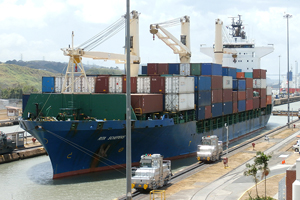Panama Canal Tour Sparks Talks on Need for Infrastructure Funds

This story appears in the April 14 print edition of Transport Topics.
The Panama Canal expansion project was intricate and inspiring for leading trucking executives, who said they are now more convinced than ever of the urgent need for U.S. highway funding in order to handle the larger freight volumes bound to emerge at ports in the coming years.
“The expansion project in and of itself is a construction marvel, and to see the current canal operations was also quite impressive,” said Bill Graves, president of American Trucking Associations, who led a delegation to survey the development.
Click here to see TT’s Panama Canal photo gallery: https://www.ttnews.com/galleries/panama2014
“I have been on a lot of trips and seen a lot of things in 29 years with UPS all over the world,” added Pat Thomas, a UPS senior vice president and ATA vice chairman. “This was one of the most interesting and fascinating trips I have ever taken.”
The expansion, approved by the citizens of Panama during a 2006 vote, includes building two new sets of locks that will raise the maximum ship size to 13,200 20-foot equivalent unit containers — more than double the current limit — Canal officials said.
Those new supersize containerships are due to start coming through the 50-mile-long ship canal that connects the Atlantic Ocean to the Pacific Ocean next year, along with about 98% of all existing cargo ships. Each of the new sets of locks, one on the Pacific and one on the Atlantic side, will have three chambers and each chamber will have three water reutilization basins.
Many ports along the Gulf and Atlantic coasts of the United States are undergoing dredging projects in the hopes of winning some of the business currently flooding West Coast ports.
ATA Chairman Philip Byrd, also in the delegation, said he found it “quite revealing” that Panama Canal Authority officials were interested in the highway-funding shortfall in the United States.
Byrd agreed that the lack of a sustainable source of highway funding could threaten some of the growth potential in the United States..
The law funding highways, MAP-21, expires Sept. 30. Without a new bill, or an extension, the federal government will not be able to collect fuel taxes or send highway construction money to states — some of which are already dredging at ports to prepare to receive the cargo-laden ships from the Panama Canal.
“The concentration of containers from such large vessels will clearly affect our highway system,” Byrd said. “When you think about highway congestion delays, it could affect [ocean] liners who say, ‘We can get just as much bang for our buck going to the West Coast.’ ”
Byrd is president of Bulldog Hiway Express in North Charleston, S.C. Its local division moves freight from the ports of Charleston, S.C., and Savannah, Ga.
Other executives in the ATA delegation were: Duane Long, first vice chairman and chairman of Longistics; Dave Manning, vice chairman and president of Tennessee Express; Bob Costello, ATA senior economist; Martin Rojas, ATA vice president of security and operations; and Jeff Mason, ATA executive vice president of communications and public affairs.
Graves said the group’s meeting with Panama Canal officials was just as impressive as the tour of canal operations.
Initially scheduled for about 45 minutes, it turned into a more than 90-minute educational dialogue that immersed the U.S. truckers with details about the canal construction and operations.
Then, Graves said, Jorge Quijano, CEO of the authority, probed the group about U.S. intermodal operations, chassis pools, port expansion projects and the idea of using rail corridors to move freight inland before distributing it further by truck.
“We went into the meeting anticipating we would listen and he would talk,” Graves said. “But as it turned out, he was as interested” in the trucking leaders’ perspectives.
Graves said there is no consensus yet on how quickly the expansion will shift cargo from the West Coast — home to the ports of Los Angeles and Long Beach, respectively the nation’s largest seaports — to the Gulf and eastern United States.
But he said he “can’t see it not having some impact, given how centered we are on trade with Asia.”
Costello, however, said freight flow for truckers would be more gradual, since the initial increase through the canal is likely to be bulk commodities.
He also said that when the expansion is completed, the increase in the number of ships coming through will be fairly small, but the total freight will rise significantly.
Graves added that the Panama Canal expansion could open additional opportunities for exporting natural gas from the United States to Asia, most likely originating in the Gulf of Mexico.

